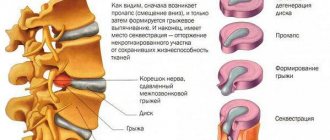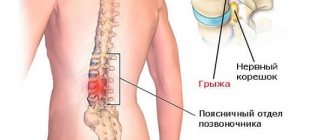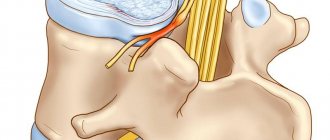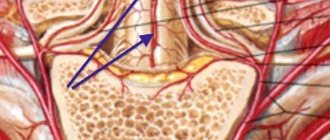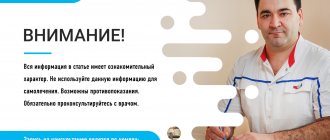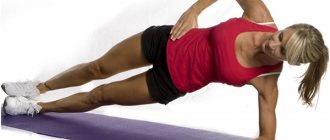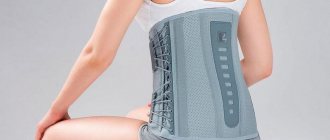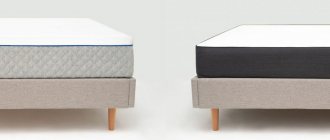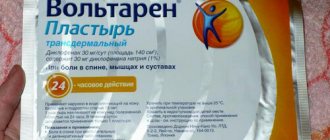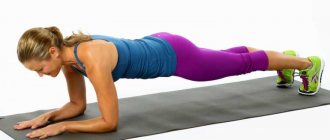A person's lower back, even if he is not overweight, always bears a very large load. After all, upright walking is the only way for a person to move. Most often, acute pain in the lumbar spine and the problems of its treatment are associated with pathology of the deep muscles of the back and with hernias and protrusions of discs.
However, when acute back pain first occurs, it is unclear what caused it. Back pain can occur due to:
- osteochondrosis and its complications, that is, with protrusions and hernias of the lumbar spine;
- spinal canal stenosis;
- inflammation of the nerve roots, or radiculitis;
- spondylolisthesis and scoliosis, when the vertebrae are connected to each other at abnormal angles;
- inflammatory conditions such as rheumatoid arthritis, tuberculosis, brucellosis.
Finally, the cause of acute lower back pain may be a paravertebral tumor or metastases to the spine. And if it is known that the cause is a hernia, then how does the lower back hurt?
What is a lumbar disc herniation
The lumbar region includes 5 vertebrae, between which are intervertebral discs. Each of them is a fibrocartilaginous formation, which consists of a fibrous ring and a nucleus pulposus.
The spinal discs perform a shock-absorbing function, that is, they soften and absorb stress on the back when moving. Thanks to it, optimal flexibility of the spinal system is maintained.
If the discs are frequently exposed to negative influences, then gradually the annulus fibrosus may become less strong. Also, due to injuries, cracks appear and other problems arise. As a result, the pulp, located in the inner part, protrudes beyond the fiber. It is this condition that is commonly called lumbar hernia.
When this pathology appears, unpleasant symptoms are observed, mobility decreases and the quality of life deteriorates. It is recommended to understand how to treat a herniated disc and use the recommendations.
Surgery for hernia of the lumbosacral spine
Surgery is a last resort, which is resorted to when conservative treatment is ineffective or immediately when:
- severe cauda equina syndrome (neurological deficit);
- paralysis;
- sequestered hernias.
The surgical techniques used today to remove intervertebral hernias of the lumbosacral spine are distinguished by a high level of safety and effectiveness. They allow you to remove hernias of almost any size and eliminate compression of the spinal roots. At the same time, modern minimally invasive operations ensure the best possible cosmetic result.
Today, for hernias of the lumbosacral region, the following are used:
- puncture surgery (nucleoplasty);
- endoscopic surgery;
- microdiscectomy.
The surgical tactics are determined individually for each patient. In this case, not only the size of the hernia, its type, but also the general condition of the patient are taken into account. Therefore, immediately before surgery, each patient undergoes a comprehensive preoperative examination.
Sometimes the characteristics of the disease require neurosurgeons to remove not only the hernia itself, but also the entire disc. In such situations, even at the stage of planning the operation, the doctor will warn the patient about the need to install an endoprosthesis to replace the removed disc or use techniques to achieve spinal fusion, i.e. fusion of adjacent vertebral bodies. The first option is preferable because it allows you to maintain normal mobility and flexibility of the spine, especially if it is necessary to remove not just one hernia of the lumbosacral region, but also neoplasms in other parts of the spine.
If for financial reasons or other reasons the installation of endoprostheses is impossible, rigid stabilization techniques are used to close the defect, sometimes involving the installation of an autograft. As a result, the last lumbar vertebra, the sacrum, grows together, which somewhat limits the patient’s mobility. As a result, he will not be able to bend over as much as was possible before, or make body turns with the same amplitude.
Percutaneous or puncture surgery
Some modern neurosurgeons have unique methods for treating small intervertebral hernias through a pinpoint puncture with a thin puncture needle. Such operations are almost completely free of intraoperative risks and do not require long, complex rehabilitation. In most cases, patients after percutaneous removal of a lumbosacral intervertebral hernia (nucleoplasty) can leave the clinic on the same day and return to their normal lifestyle with minor restrictions.
The essence of the operation is to introduce, under X-ray control, a thin cannula into the center of the nucleus pulposus of the affected disc, through which the working electrode is then immersed. It creates heat or other energy. The surgeon makes several back-and-forth movements with the electrode in different directions without moving it beyond the disc. As a result, “brewed” passages are formed in the nucleus pulposus, and its total volume decreases. This creates negative pressure in it, which leads to retraction of the protrusion. The operation takes 30–40 minutes, after which the electrode along with the cannula are removed from the patient’s body, and the postoperative puncture is covered with a sterile bandage, without even stitches.
Today, there are several techniques for performing nuclecoplasty. This:
- hydroplastics
- cold plasma;
- laser
They all have the same technology, but energy of different origins is used to destroy the nucleus pulposus.
A special technique of puncture surgery used for hernia of the lumbosacral region is hydroplasty. This operation has the same goals as other types of nucleoplasty, but liquid pressure is used to destroy part of the nucleus pulposus.
As in the first case, a thin conductor is inserted into the patient’s body in the projection of the L5–S1 disc into the center of the intervertebral disc. It has 2 branches: through the first, liquid is supplied into it under pressure, and through the second, waste material with particles of the nucleus pulposus is simultaneously aspirated and removed. The method allows you to very accurately control the degree of destruction and achieve ideal results.
Thus, nucleoplasty allows you to achieve excellent treatment results and avoid the formation of the slightest scars on the skin. But it may not always be carried out. Thus, they are not used to treat sequestered hernias or those larger than 7 mm.
Nucleoplasty can be performed under local anesthesia.
Endoscopic removal of lumbosacral intervertebral disc herniation
Endoscopic operations involve the use of special endoscopes equipped with LEDs and video cameras that transmit images in real time to a monitor. The neurosurgeon can precisely control every movement of the instruments immersed through the endoscope and accurately remove hernias of almost any size.
Endoscopic operations are indicated for large hernias, as well as their location in narrow areas of the spinal canal, for example, in the area of the foraminal openings. They are characterized by a high level of safety, effectiveness and a short rehabilitation period.
Microdiscectomy
Microdiscectomy is a classic method of surgical treatment of intervertebral hernias of the lumbosacral spine. It is also called the “gold standard” of surgery. The operation is performed exclusively under general anesthesia. To gain access to the affected disc, an incision of up to 3 cm is made in its projection.
After this, the surgeon carefully moves the soft tissues apart and fixes them in a comfortable position. Since the muscles are not injured, the recovery period is sharply reduced and is much easier than with previously used discectomy. In this case, the operation does not imply a violation of the integrity of the ligamentum flavum.
Microdiscectomy is performed using a special surgical microscope that provides 8x magnification. This allows you to eliminate both the hernia itself and the entire intervertebral disc, if necessary. In the first case, the hernia is carefully resected using special microsurgical instruments, and the disc itself is preserved. The resulting defect is closed with a special mesh, which is a synthetic substitute for the fibrous ring. Microdiscectomy can also be used to remove sequestered hernias.
If the L5–S1 intervertebral disc is severely damaged, it can be completely removed during microdiscectomy. After this, endoprostheses can be installed in the resulting space, or rigid stabilization techniques can be used to maintain the unity of the spine.
The final stage of the operation is treating the wound with antiseptics and applying postoperative sutures.
The operation gives especially good results when performed no later than 3 months after its appointment.
Reasons for appearance
There are many reasons for the appearance of a hernia; they can be divided into two groups: exogenous and endogenous. The first are external, and the second are internal.
Exogenous causes:
- Tumors of different etiologies.
- Syphilis, tuberculosis.
- Back injuries.
- Excessive stress, too active lifestyle.
- Excess weight.
- Lordosis, scoliosis, osteochondrosis.
- Sedentary lifestyle. Because of this, the distribution of the load on the spine is disrupted, and the muscle corset is weakened.
Endogenous causes:
- The intervertebral discs do not receive enough nutrients.
- Dysfunction is associated with natural aging of the body.
- With age, the concentration of water in the body decreases, which leads to drying of the discs.
You can also identify risk factors that increase the likelihood of a problem occurring in the body. For example, a hernia often appears in men between the ages of 30 and 50. It is also caused by smoking, sedentary work, hypothermia, and emotional stress. It is recommended to understand how to treat a lumbar disc herniation in order to take action and improve your health. The disease tends to progress, so it cannot be neglected.
Symptoms
The presence of a spinal hernia can be detected by characteristic signs. The pathology begins slowly, and at first there are almost no symptoms. The trigger can be a sudden movement or lifting of weight. This leads to severe pain.
The first signs are blurred, it is easy to not notice them and not ask the question of how to cure a herniated disc. A person may not pay attention to the symptoms, because they are not yet too disturbing.
The first symptoms are a feeling of fatigue in the lower back, numbness of the skin in the lower extremities, weakness in the legs and gait disturbance. Usually people attribute this to normal overwork. If nothing is done at this stage, then more obvious signs will appear. There will be pain in the lumbar region, rheas can be both weak and sharp. A person quickly gets tired when walking and suffers from muscle weakness. The skin becomes pale and vascular spots appear on it.
The most dangerous symptoms are paralysis and paresis. They appear due to compression of the spinal cord. The functioning of the pelvic organs may also be disrupted, which will lead to urine, feces and infertility. To prevent this, you need to figure out in time how to treat a hernia of the lumbar spine.
List of popular and effective drugs
Listed below are the best popular drugs for the treatment of acute back pain, caused, among other things, by the presence of protrusions and herniated intervertebral discs. First, the international nonproprietary name (INN) is given, which is common to all commercial analogues (or generics) of this medicine. Then - the original drug with this INN. Then some popular generics are given.
For each medicine, the average cost is given that is relevant for pharmacies of all forms of ownership in the Russian Federation for the end of June 2021. There is no ranking, first or last places are not provided.
Diagnosis of the disease
To make a diagnosis, you will need to conduct neurological tests and instrumental studies. A neurologist will test your neurological status. This task can also be performed by a neurosurgeon or orthopedist. Diagnosis begins with an initial examination, during which a specialist evaluates muscle strength and tendon reflexes. He may suspect a hernia.
To confirm the diagnosis, the doctor will refer you for an MRI or MSCT. Based on the results of these studies, it is possible to accurately determine the disease.
Drug treatment
The doctor will most likely prescribe medication. The drugs can eliminate unpleasant symptoms, so taking anti-inflammatory or painkillers is required. For example, a doctor may prescribe Diclofenac or Ibuprofen. With the help of these drugs it will be possible to relieve pain and also prevent muscle tissue atrophy.
If the patient feels stiffness of movement or suffers from spasms, then the doctor will prescribe Mydocalm and Sirdalud. These are relaxing remedies that will quickly improve the patient’s well-being.
There are other answers to the question of how to cure a hernia of the lumbar spine. It is necessary not only to take medications, but also to undergo some other procedures.
Drugs from the NSAID group
Drugs from the NSAID group have three important medicinal qualities: they reduce inflammation, reduce pain and reduce fever, or temperature. For the latter, we are not interested in the quality of protrusions and hernias.
It is important to know that all NSAID drugs, without exception, have contraindications, and the oldest first-generation drugs, such as Diclofenac or Voltaren, generally cannot be used for more than two to three days. All of them can aggravate the course of gastric and duodenal ulcers, and in exceptional cases even cause ulcerative bleeding. They lead to exacerbation of erosive gastritis, and with prolonged uncontrolled use for several weeks they can lead to drug-induced toxic hepatitis.
Despite the very low safety profile, Diclofenac, although an “ancient” drug, is still considered one of the most effective and potent. Other drugs, such as meloxicam and ketoprofen, are already second-generation drugs; they are safer to use, although the same rules apply to intramuscular injections: no longer than 3 to 5 days.
Meloxicam (Movalis, Amelotex, Artrosan, Mirlox, Revmart)
Movalis, or the original drug meloxicam, first produced by the German company Boehringer Ingelheim, is one of the best in its group. In addition to relieving acute back pain, it is indicated for various forms of arthritis, joint pain, rheumatological diseases, and other inflammatory lesions of the musculoskeletal system.
Meloxicam has a strong anti-inflammatory effect, you need to inject it 1.5 ml intramuscularly daily for 3 days. Then it is used in tablets, one 7.5 mg tablet once a day. But taking even the tablet form should not be long-term. The medicine is contraindicated in patients with bronchial asthma, nasal polyposis, with exacerbation of erosive gastritis and gastric ulcer, with severe hepatic renal failure, during pregnancy, breastfeeding, and under 12 years of age.
Movalis is produced by Boehringer Ingelheim, and a package of 3 ampoules (for a short course) of 1.5 ml each costs, on average, 610 rubles.
Ketoprofen (Ketonal, Artrosilene, Flamax)
The drug ketoprofen, of which Ketonal is a representative, is also very popular, and is available not only in a solution for intramuscular administration, but also in the form of a gel for topical use, which will be described below, in tablets, as well as in the form of rectal suppositories.
Ketoprofen is indicated for the same pathology with some changes: for arthritis, exacerbation of spinal osteochondrosis - protrusions and hernias, for migraines and headaches, various forms of neuralgia and radiculitis, for gout, as well as for postoperative pain syndrome, including after microdiscectomy.
Intramuscular administration involves one ampoule (100 mg) once or twice a day, the maximum daily dose is 2 ampoules. The drug also has a pronounced range of contraindications. In addition to the above contraindications to Movalis, Ketonal cannot be used for hemophilia or decompensated heart failure. It should not be used in children under 15 years of age. Ketonal, produced by the Sandoz company from Austria, costs 225 rubles. per pack of 10 ampoules.
Diclofenac (Voltaren, Diclobene, Diclovit, Dorosan, Ortofen)
Finally, the third drug widely used for protrusions and hernias is diclofenac, and perhaps the purest and most highly effective is the original Voltaren, produced by the Swiss company Novartis. Its cost is, on average, 260 rubles. per pack of 3 ampoules of 5 ml. But there are also more affordable analogues. Thus, diclofenac, produced by the Serbian company Hemofarm, will cost only 40 rubles for the same package. This indicates the high popularity of this drug.
Voltaren is an effective pain reliever: the effect occurs within 20-30 minutes. This drug is also widely used for various inflammatory and degenerative lesions of the musculoskeletal system, for back pain, lumbago, cervicalgia, sciatica, including protrusions and hernias. It is also indicated for severe migraine attacks.
Intramuscularly, it should be injected deeply, the dosage should be once a day, and in case of particularly severe pain, injections can be given twice a day, with an interval of several hours. It is recommended to use the lowest possible dose and the shortest possible course of treatment.
Physiotherapy
In case of a hernia, doctors strongly recommend exercise therapy, since the gymnastic complex helps prevent the progression of the pathology. The exercise should be performed only after the discomfort disappears. The treatment program is prescribed by the instructor, focusing on the individual characteristics of the patient.
The main goal of the treatment program is to improve muscle condition and prevent further changes in the position of the disc. The patient will have to bend, lift, rotate the arms and body, as well as other exercises.
There are other physiotherapeutic methods of treatment, for example, influencing special points with needles, treatment with warm compresses. Spinal traction is also performed using the Ormed apparatus. All this allows you to quickly improve a person’s health.
Surgery
In advanced cases, the doctor may prescribe surgery. Surgical intervention cannot be avoided when the source of inflammation is in the area of the sciatic nerve, the disc has ruptured, or its position has changed significantly.
A procedure such as a discectomy may be performed. It involves removing part of the disc using a special needle. In addition, the problem area can be treated with a laser. This eliminates excess fluid and frees the nerve. In extreme cases, the doctor can remove the weight disc and then perform prosthetics.
Prevention
It is easier to prevent a disease than to cure it, so you need to take care of prevention. Typically, a hernia appears against the background of sudden or regular stress. You should not overwork, lift heavy objects, or make sudden movements. For sleep, you should choose orthopedic massage. It is recommended to fall asleep on your back, as this is the most favorable position.
It is important to prevent the appearance of excess weight, as it leads to many health problems. You must not forget about correct posture and try to keep your back straight.
If the pathology is not treated, it will lead to intense pain, problems with the genitourinary system, and muscle weakness in the legs. To prevent this, you should consult a doctor in a timely manner and begin therapy. The result will appear quite quickly; symptoms should subside within the first week if the treatment is chosen correctly. The main thing is to follow the specialist’s recommendations and try to eliminate the causes that can lead to the progression of the pathology.
Need for medical assistance
Regular back pain cannot be ignored. Often a painful syndrome can signal overwork, but herniated disc protrusions cannot be ruled out. You should be especially concerned about:
- pain radiating to the lower extremities, which intensifies during movement;
- painful sensations in the legs at rest, impaired sensitivity;
- increased muscular-tonic syndrome;
- discomfort, stiffness and limited movements, inability to move independently;
- loss of control over the processes of urination and defecation.
If the above signs appear, you need to visit a doctor urgently. Only a specialist neurosurgeon can make an accurate diagnosis after examination and diagnostic tests. Modern diagnostic equipment allows you to choose the right treatment method for diseases such as intervertebral hernia, as well as cervical osteochondrosis.
